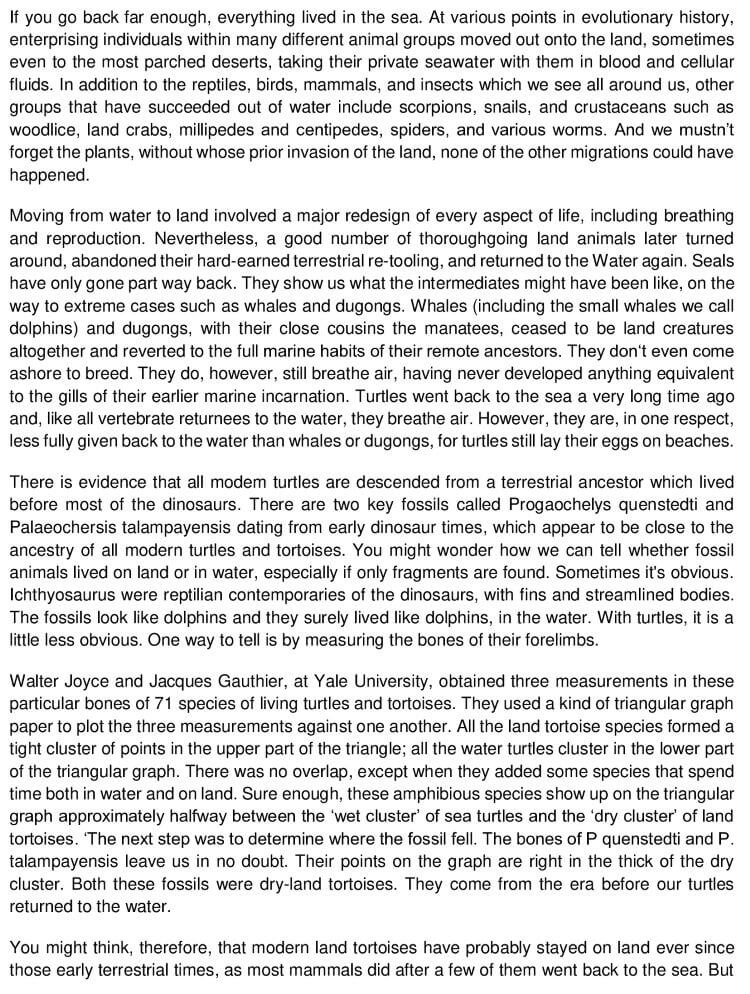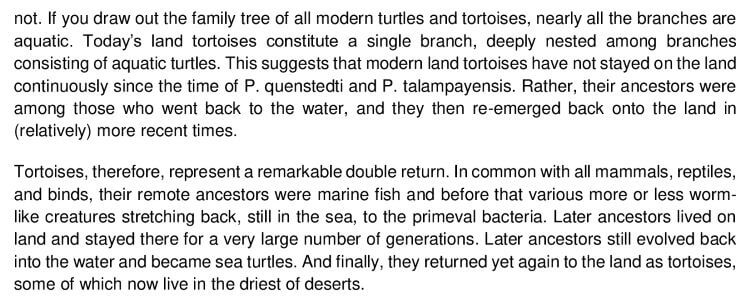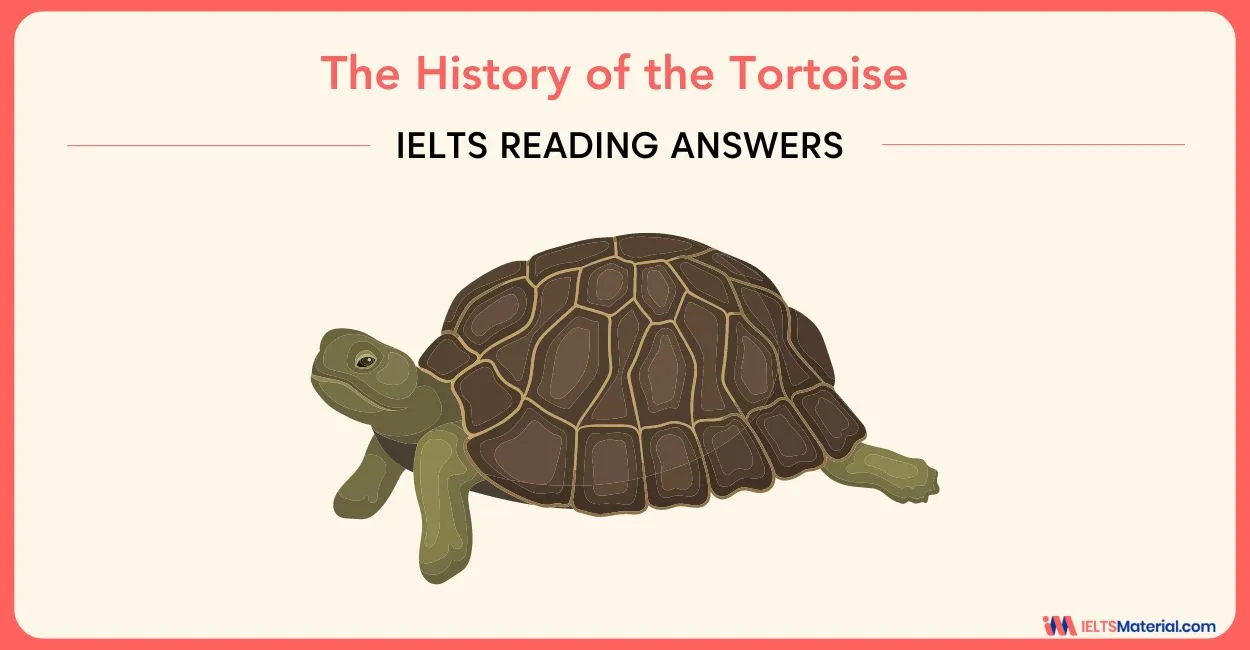The History of the Tortoise – IELTS Reading Answers
13 min read
Updated On
-
Copy link
Dive into the IELTS Academic Reading Passage on 'The History of the Tortoise – IELTS Reading Answers' and elevate your preparation to score a band 8+ in the IELTS exam.
Table of Contents

Limited-Time Offer : Access a FREE 10-Day IELTS Study Plan!
IELTS Academic Reading consists of 40 questions divided over three passages, similar to The History of the Tortoise – IELTS Reading Answers. It can be difficult for some test-takers to complete the test within 60 minutes. To master this section, you should begin practising IELTS Reading passages like The History of the Tortoise – IELTS Reading Answers on a regular basis.
The Academic passage, The History of the Tortoise, is a reading passage that is part of the Cambridge IELTS 9 Reading Test 1 and contains some of the IELTS reading question types. If you are interested in familiarizing yourself with all the question types, don’t hesitate to take an IELTS reading practice test.
The passage, The History of the Tortoise, is an IELTS Academic reading passage that consists of 14 questions.
The question types found in this passage are:
- IELTS Reading Short-Answer Type Question (Q. 1-4)
- True/False/Not Given IELTS Reading (Q. 5-7)
- Flowchart/IELTS Sentence Completion (Q. 8-13)
- IELTS Reading Multiple-Choice Questions (Q. 14)
Reading Passage
The History of the Tortoise


Questions 1-4
Answer the questions below.
Choose NO MORE THAN TWO WORDS from the passage for each answer.
Write your answers in boxes 1-4 on your answer sheet.
1 What had to transfer from sea to land before any animals could migrate?
2 Which TWO processes are mentioned as those in which animals had to make big changes as they moved onto land?
3 Which physical feature. possessed by their ancestors, do whales lack?
4 Which animals might ichthyosaurs have resembled?
Questions 5-7
Do the following statements agree with the information given in the Reading Passage?
In boxes 5-7 on your answer sheet, write
TRUE if the statement agrees with the information
FALSE if the statement contradicts the information
NOT GIVEN if there is no information on this more than once.
5 Turtles were among the first group of animals to migrate back to the sea.
6 It is always difficult to determine where an animal lived when its fossilized remains are incomplete.
7 The habitat of ichthyosaurs can be determined by the appearance of their fossilized remains.
Questions 8-13
Complete the flow-chart below.
Choose NO MORE THAN TWO WORDS AND/OR A NUMBER from the passage for each answer.
Write your answers in boxes 8-13 on your answer sheet.
Method of determining where the ancestors of turtles and tortoises come from
- Step 1: 71 species of living turtles and tortoises were examined and a total of 8 ……………. were taken from the bones of their forelimbs.
- Step 2: The data was recorded on a 9 ………………. (necessary for comparing the information). Outcome: Land tortoises were represented by a dense 10 ……………… of points towards the top. Sea turtles were grouped together in the bottom part.
- Step 3: The same data was collected from some living 11 ……………… species and added to the other results. Outcome: The points for these species turned out to be positioned about 12 ……………… up the triangle between the land tortoises and the sea turtles.
- Step 4: Bones of R quenstedti and P talampayensis were examined in a similar way and the results were added. Outcome: The position of the points indicated that both these ancient creatures were 13………………….
Questions 14
Choose the correct letter A, B, C, or D.
Write the correct letter in box 14 on your answer sheet.
14 According to the writer, the most significant thing about tortoises is that
A they are able to adapt to life in extremely dry environments.
B their original life form was a kind of primeval bacteria,
C they have so much in common with sea turtles.
D they have made the transition from sea to land more than once.
Answers of The History of the Tortoise Reading Answers With Location and Explanations
1 Answer: plants
Question type: Short Answer Question
Answer location: Paragraph 1
Answer explanation: In the last line of the first paragraph, it is stated, “And we mustn’t forget the plants, without whose prior invasion of the land none of the other migrations could have happened.” We can understand from these lines that plants had to transfer from sea to land before any animals could migrate, that is prior to the invasion of the land. Thus, the answer is to plant.
2 Answer: breathing and reproduction
Question type: Short Answer Question
Answer location: Paragraph 2
Answer explanation: The introductory lines of the 2nd paragraph states that moving from water to land involved a major redesign of every aspect of life, including breathing and reproduction. These lines indicate that breathing and reproduction were the two processes in which animals had to make big changes as they moved out of the land. Thus, the answer is breathing and reproduction.
3 Answer: gills
Question type: Short Answer Question
Answer location: Paragraph 2,line 9
Answer explanation: We find a reference for Whales in the 2nd paragraph, which states that Whales (including the small whales we call dolphins) and dugongs, with their close cousins the manatees, ceased to be land creatures altogether and reverted to the full marine habits of their remote ancestors. They don‘t even come ashore to breed. In the 9th line of the 2nd paragraph, it is stated that they do, however, still breathe air, having never developed anything equivalent to the gills of their earlier marine incarnation. These lines suggest that although the gills were possessed by their ancestors, Whales lacked gills as their physical characteristics. Hence, the answer is gills.
4 Answer: dolphin
Question type: Short Answer Questions
Answer location: Paragraph 3,line 6
Answer explanation: The 6th line of the 3rd paragraph states that Ichthyosarus were reptilian contemporaries of the dinosaurs, with fins and streamlined bodies. The fossils look like dolphins and they surely lived like dolphins, in the water. It is evident from these lines that dolphins resembled ichthyosaurs. Hence, the answer is dolphins.
5 Answer: Not Given
Question type: True/ False/ Not Given
Answer location: Paragraph 2, line 2
Answer explanation: We find a reference in the 2nd line of paragraph 2, which states that Nevertheless, a good number of thoroughgoing land animals later turned around, abandoned their hard-earned terrestrial re-tooling, and returned to the Water again. Although these lines indicate that a large number of thoroughgoing land animals went back to the sea again, it is not mentioned whether the turtles were the first group of animals to migrate back to the sea. Thus, the answer is Not Given.
6 Answer: False
Question type: True/ False/ Not Given
Answer location: Paragraph 3, line 5
Answer explanation: Paragraph 3, Line 5 states the writer saying, “You might wonder how we can tell whether fossil animals lived on land or in water, especially if only fragments are found. Sometimes it’s obvious.” These lines indicate that though the fossilized remains are in fragments (incomplete), it’s not always difficult (sometimes it’s obvious) to determine if the animal lived in water or land. Thus, the statement agrees with the information, so, the answer is True.
7 Answer: True
Question type: True/ False/ Not Given
Answer location: Paragraph 3, line 6
Answer explanation: In the 6th line of paragraph 3, it is mentioned that Ichthyosarus were reptilian contemporaries of the dinosaurs, with fins and streamlined bodies. The fossils look like dolphins and they surely lived like dolphins, in the water. These lines indicate that the habitat of ichthyosaurus can be determined by the appearance of their fossilized remains. Hence, the statement agrees with the information, so, the answer is True.
Unlock Remaining Explanations
8 Answer: 3 measurements
Question type: Flowchart Completion
Answer location: Paragraph 4
Answer explanation: The initial lines of the 4th paragraph states that Walter Joyce and Jacques Gauthier, at Yale University, obtained three measurements in these particular bones of 71 species of living turtles and tortoises. They used a kind of triangular graph paper to plot the three measurements against one another. It is evident from these lines that 71 species of living turtles and tortoises were examined and a total of 3 measurements were taken from the bones of their forelimbs. Thus, the answer is 3 measurements.
9 Answer: (triangular) graph
Question type: Flowchart Completion
Answer location: Paragraph 4,line 3
Answer explanation: The 3rd line of the 4th paragraph illustrates that a kind of triangular graph paper was used to plot the three measurements against one another. These lines suggest that the data was recorded using a triangular graph which was necessary for comparing the information. Thus, the answer is a (triangular) graph.
10 Answer: cluster
Question type: Flowchart Completion
Answer location: Paragraph 4,line 4
Answer explanation: The 4th line of the 4th paragraph reveals that all the land tortoise species formed a tight cluster of points in the upper part of the triangle; all the water turtles cluster in the lower part of the triangular graph. We can deduce from these lines that when the data was recorded using a triangular graph, the land tortoises were represented by a dense (tight) cluster of points towards the top, and the sea turtles were all grouped in the bottom part. Thus, the answer is a cluster.
11 Answer: amphibious
Question type: Flowchart Completion
Answer location: Paragraph 4, line 6
Answer explanation: Paragraph 4, line 6 states that there was no overlap, except when they added some species that spend time both in water and on land. Sure enough, these amphibious species show up on the triangular graph approximately halfway between the ‘wet cluster’ of sea turtles and the ‘dry cluster’ of land tortoises. It is clear from these lines that the same data was collected from some living amphibious species and added to other results. Hence, the answer is amphibious.
12 Answer: halfway
Question type: Flowchart Completion
Answer location: Paragraph 4,line 6
Answer explanation: We can understand from the 6th line of the 4th paragraph that when there was no overlap, some data was collected from some living amphibious species and added to other results. These amphibious species show up on the triangular graph approximately halfway between the ‘wet cluster’ of sea turtles and the ‘dry cluster’ of land tortoises, that is the points for the amphibious species turned out to be positioned about halfway up the triangle between the land tortoise and the sea turtles. Thus, the answer is halfway.
13 Answer: dry-land tortoises
Question type: Flowchart Completion
Answer location: Paragraph 4,last line
Answer explanation: The last line of the 4th paragraph states that the bones of P quenstedti and P. talampayensis leave us in no doubt. Their points on the graph are right in the thick of the dry cluster. Both these fossils were dry-land tortoises. They come from the era before our turtles returned to the water. We can deduce from these lines that the position of the points indicated that both these ancient creatures were dry-land tortoises. Thus, the answer is dry-land tortoises.
14 Answer: D
Question type: Multiple Choice Question
Answer location: Paragraph 6
Answer explanation: We can identify the most significant thing about tortoises in the last paragraph (paragraph 6)of the reading passage, where it is mentioned that tortoises, therefore, represent a remarkable double return. In common with all mammals, reptiles, and binds, their remote ancestors were marine fish and before that various more or less worm-like creatures stretching back, still in the sea, to the primeval bacteria. Later ancestors lived on land and stayed there for a very large number of generations. Later ancestors still evolved back into the water and became sea turtles. And finally, they returned yet again to the land as tortoises, some of which now live in the driest of deserts. These lines indicate that the tortoises changed their habitat from sea to land more than once. Hence, the answer is D.
Learn how to solve passages like ‘The History of the Tortoise‘ in 20 minutes!
Tips to Solve the Question Types in The History of the Tortoise IELTS Reading Answers
Since now you know the answers to the Reading Answers of The History of the Tortoise with explanation, let us check out some quick tips to answer the three types of questions in the Reading Answers of The History of the Tortoise.
Short-Answer Type Questions:
Short Answer Type Questions is a type of IELTS reading question that requires you to scan through a passage and answer questions based on the information given following the word limit.
To answer short-answer type questions, you can use the following strategies:
- Go through the instructions carefully – You will find the word limit for the answers there, which you have to follow strictly.
- Read the questions and highlight the keywords – The next step will be to read the questions to know what keywords or information you have to look for in the passage.
- Use the ‘Wh’ words in the questions – Words like ‘What’, (names), ‘Where’ (place), ‘When’ (time), etc. will enable you to understand the type of information you are looking for.
- Use reading techniques to study the passage quickly – Do not waste your time reading the whole passage. Scan through the passage to find out the keywords or their synonyms. If headers are given, use them to locate the answer easily.
- Check the spelling – Once you find the answer, note the correct spelling in your answer sheet.
True/False/Not Given
In IELTS Reading, ‘True, False, Not Given’ questions are based on facts. Several factual statements will be provided to you, and it is up to you to determine whether or not they are accurate by reading the text.
To answer this type of question, you can use the following strategies:
- Read the question and identify the keywords – Before reading the material, have a look at your list of True, False, and Not Given questions.
- Scan the passage for synonyms or paraphrased words of the keywords – When you have highlighted the keywords, swiftly read the text to look for paraphrases or synonyms.
- Match the highlighted words in the questions with their synonyms in the text – Once you find both sets of keywords, cross-check them to find the answer.
- Identify the answer – If the facts match, the answer is TRUE, and in case it doesn’t match, it is FALSE. If you are unable to find the answer or unsure of it, mark it NOT GIVEN.
Flowchart/Sentence Completion:
Answering the flowchart questions is quite similar to how we solve the sentence completion questions of the IELTS Reading test. You will be asked to fill in the blanks in incomplete phrases with the relevant words or numbers.
- Read the instructions carefully. It will help you determine the word limit (no more than two, one word, etc) and important terms like ‘using words from the text’ or ‘from the text’. You have to follow these strictly.
- Read the incomplete sentences first. Also, think about keywords and how they could be represented by synonyms or paraphrasing.
- Locate where the information is by scanning quickly. If you can’t, move on.
- Study the reading text by using the skimming and scanning techniques. It will help to establish the answer quickly. When scanning for your answer, make sure you are thinking about paraphrasing and synonyms.
- The answers appear in the same order as the questions.Also, check your spelling and remember that your answer should be grammatically correct.
Multiple-Choice Questions:
You will be given a reading passage followed by several questions based on the information in the paragraph in multiple-choice questions. Your task is to understand the question and compare it to the paragraph in order to select the best solution from the available possibilities.
- Before reading the passage, read the question and select the keywords. Check the keyword possibilities if the question statement is short on information.
- Then, using the keywords, read the passage to find the relevant information.
- To select the correct option, carefully read the relevant words and match them with each option.
- You will find several options with keywords that do not correspond to the information.
- Try opting for the elimination method mostly.
- Find the best option by matching the meaning rather than just the keywords.
Also Check:
- IELTS Reading Test 1 in 2018 with Answers – topic : Inside the mind of a fan
- The Lack of Sleep- IELTS Reading Answers
- Jupiter’s Bruises- IELTS Reading Answers
- Tips to Improve IELTS Reading Skills
- Presto Bread Machine- IELTS Reading Answers
- Nutmeg a Valuable Spice Reading Answers
- Myths about Public Speaking- IELTS Reading Answers
Practice IELTS Reading based on question types

Start Preparing for IELTS: Get Your 10-Day Study Plan Today!
Recent Articles

Nehasri Ravishenbagam

Haniya Yashfeen

Haniya Yashfeen

Haniya Yashfeen




Post your Comments